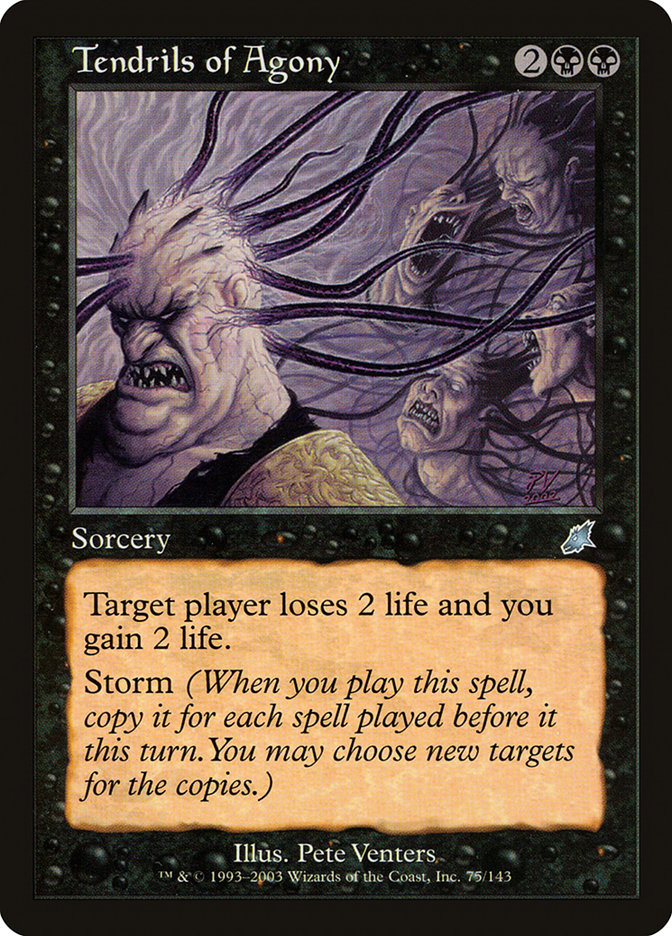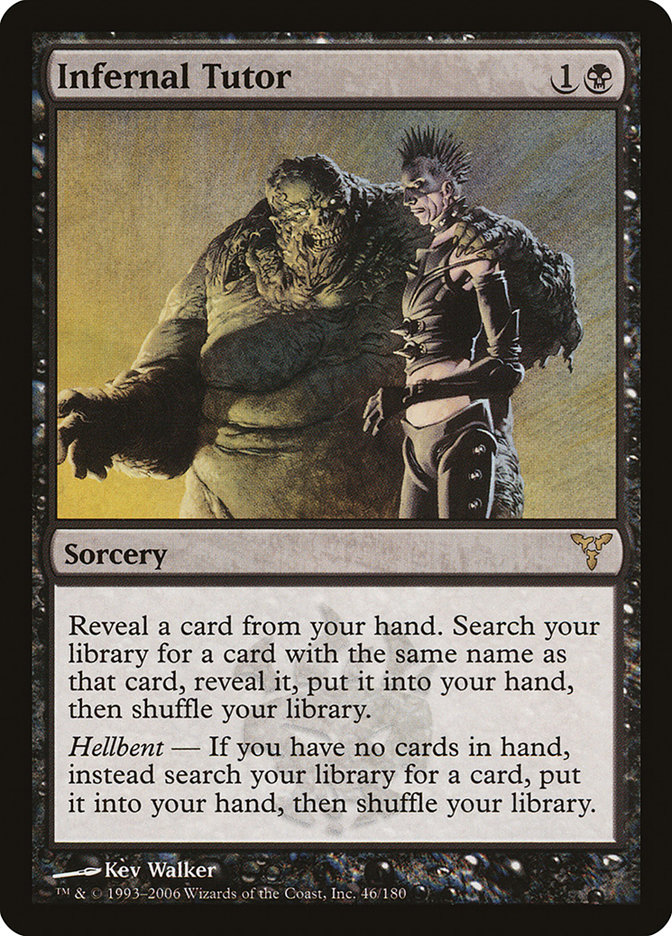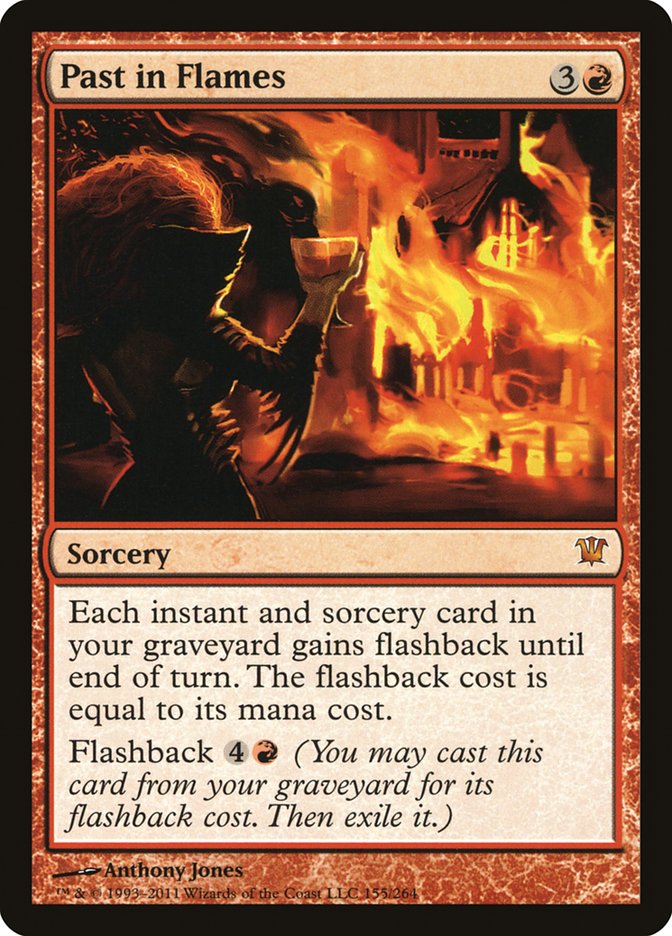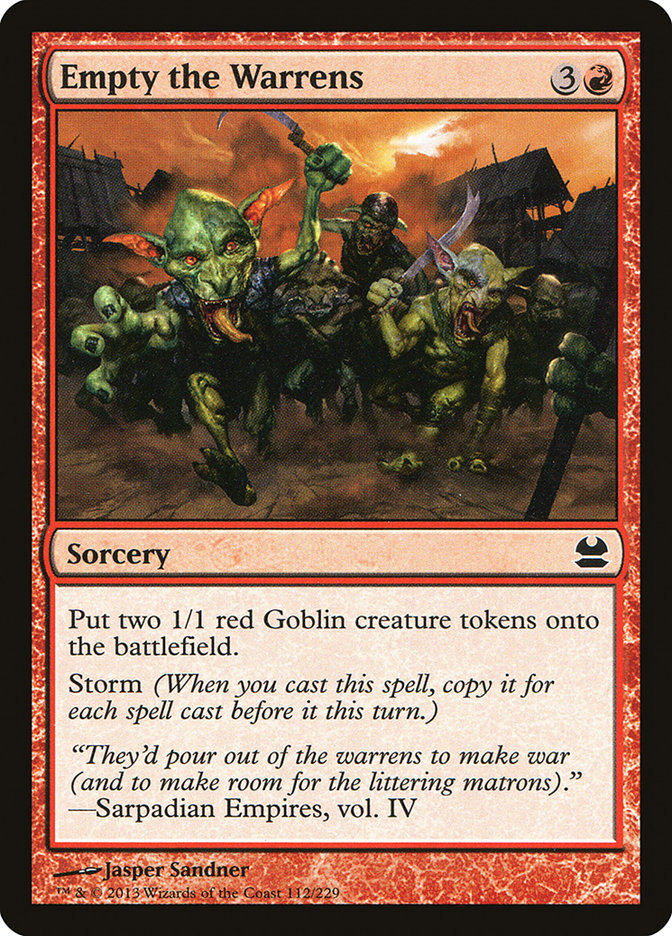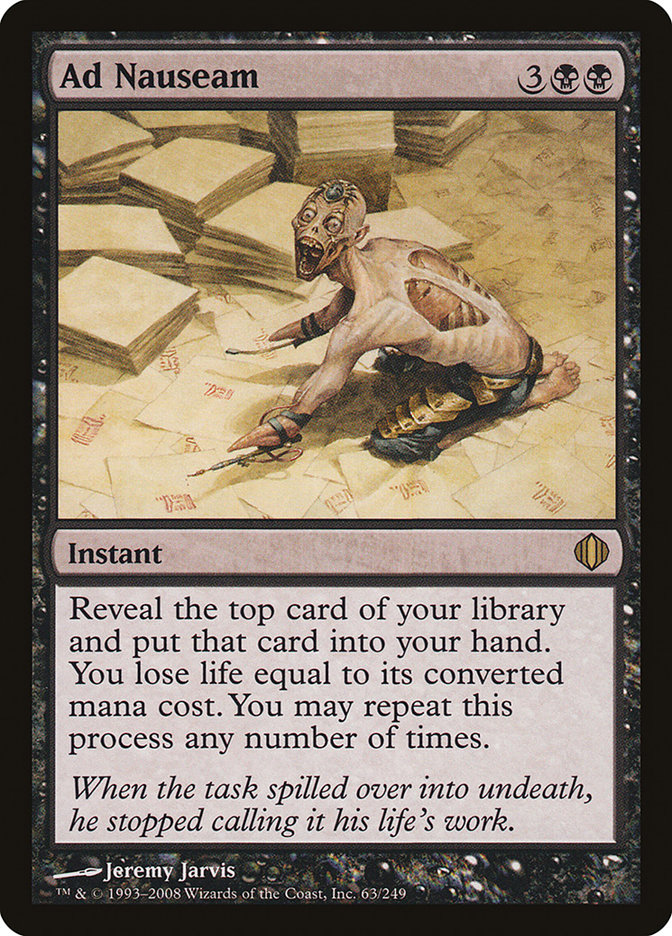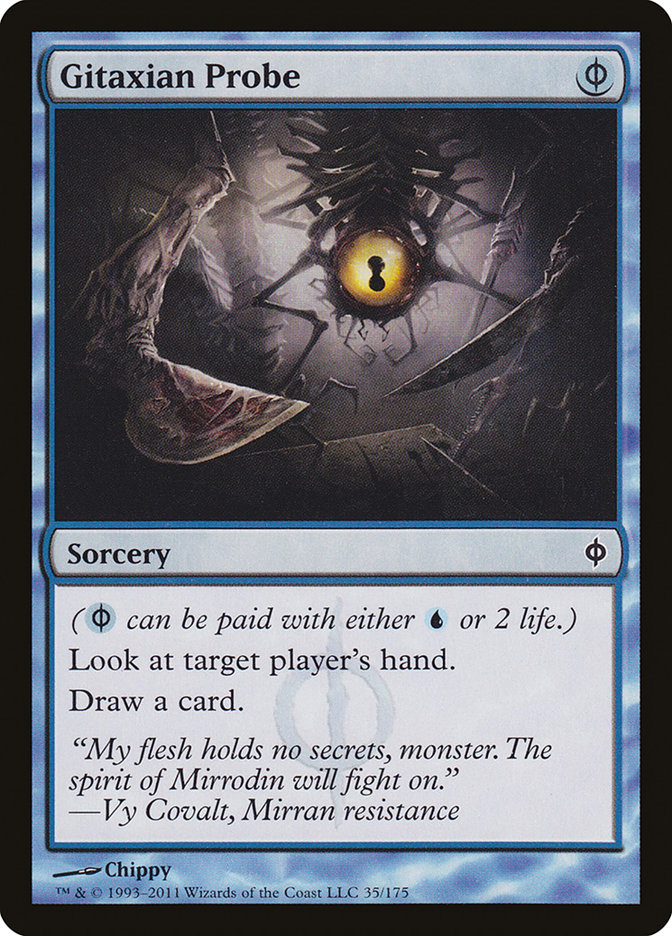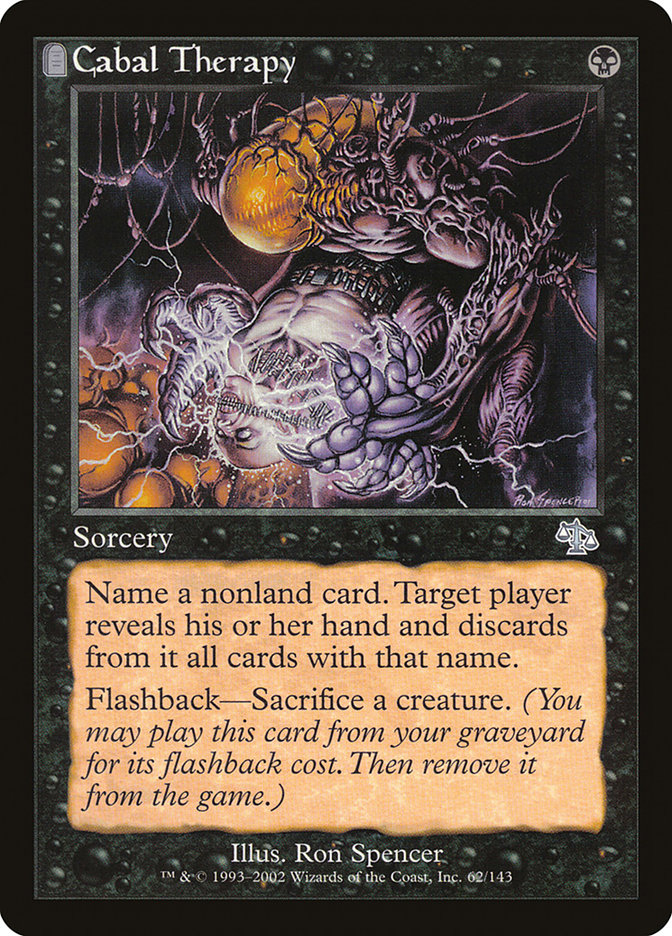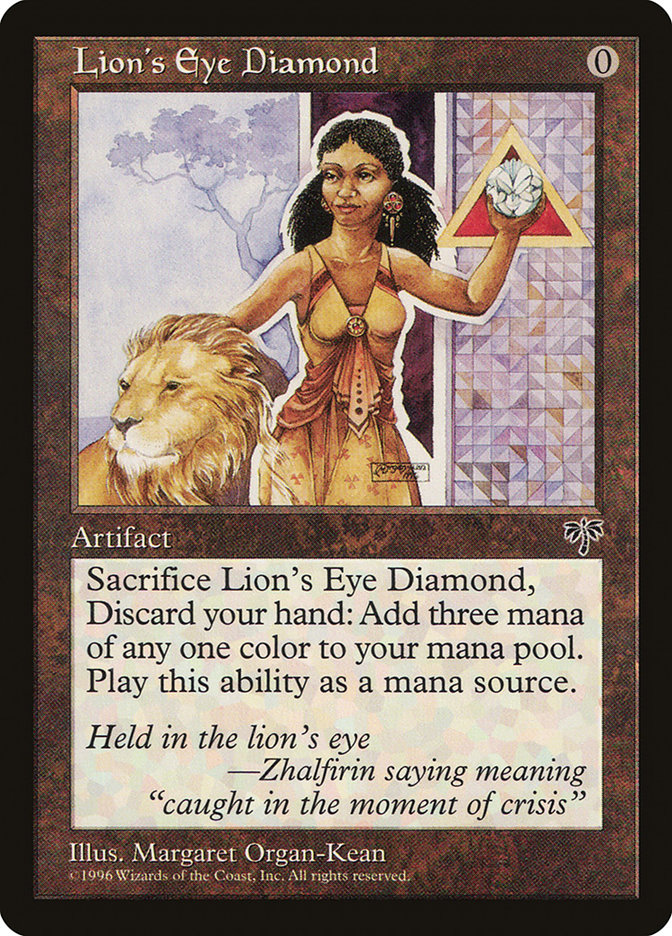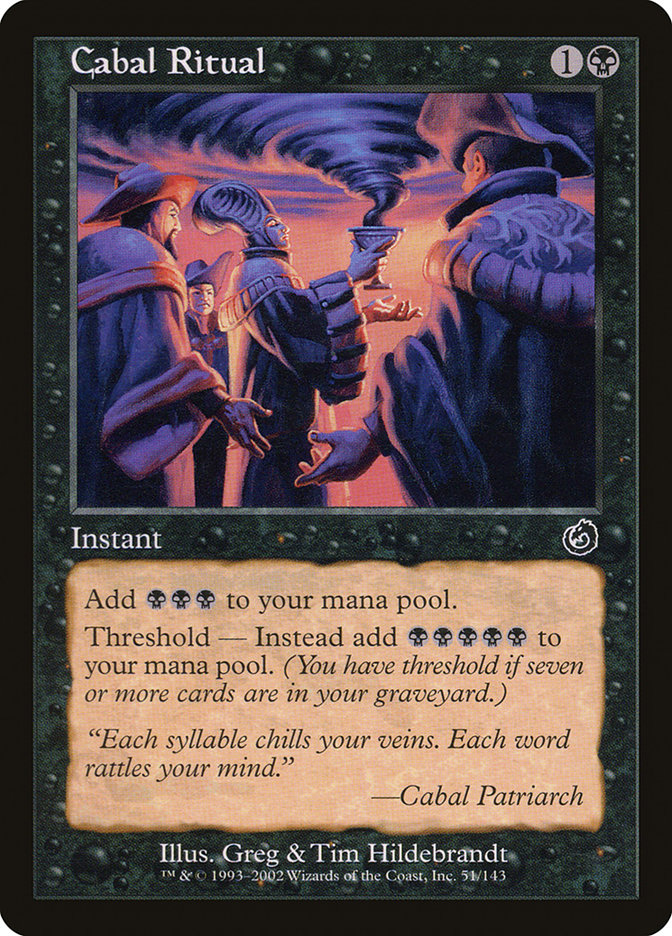Are you sick of cringing when Goblin Lackey comes down on turn 1? [Editor’s Note: Good God no!] Tired of losing to Punishing Fire one point at a time? Do you want to just laugh at an opponent that slams Jace, the Mind Sculptor into play on turn 4? Here’s your answer:
Tendrils Storm decks are considered among the hardest decks to play in the format, and with good reason. Minor misplays will often decide the outcome of a match and you regularly need to plan ahead for multiple turns and calculate complex spell chains before even casting the first spell, all the while taking all your opponent’s possible reactions into account. In short, there are a ton of interconnected decisions that need to be made in a limited amount of time and often on imperfect information, and every single one you get wrong will measurably reduce your chances of winning the game.
As such, if you want to consistently do well with a Storm deck, you really need to get used to the deck and how its matchups play out—a daunting task if you haven’t ever touched this kind of deck. The best way to learn the deck and its interactions is to find an experienced Storm player and hope they’re ready to give you some training under their capable hands. Sadly, though, not everyone has access to someone who is both willing and able to provide this training.
And that’s why I’m here to help you today. What you’ll find in the following are detailed instructions as to how I would go about learning Storm. All examples will be taken from Cabal ANT—the Tendrils deck I’m most familiar with myself—but the same methodology should help you learn to get the most out of any kind of Storm deck, up to and including what is usually considered the most difficult deck in the format DDFT (Doomsday Fetchland Tendrils).
First, a word of reassurance. It’s true that Storm is hard and that even very experienced players will often end up making multiple game-losing mistakes with it during a tournament. At the same time, though, Cabal ANT (like its brethren) has an incredible power level and some matchups which you actually have to work hard to lose. The result? Even someone who isn’t playing the deck at peak efficiency will be able to win a large number of games, mistakes or no mistakes.
Getting Started
Alright, first the good news: even though there’s a lot of work in front of you, the basics can be learned whenever you don’t have anything better to do. Reaching basic proficiency with Storm is something you can do without a playtest partner. Actually, before you even touch the cards, you should learn your chosen deck’s typical winning positions. This is the deck we’ll be looking at today (my standard list as per two weeks ago):
Lands (15)
Spells (45)
- 2 Sensei's Divining Top
- 1 Tendrils of Agony
- 4 Brainstorm
- 4 Cabal Ritual
- 4 Duress
- 4 Dark Ritual
- 2 Cabal Therapy
- 2 Lim-Dul's Vault
- 3 Lotus Petal
- 4 Lion's Eye Diamond
- 4 Infernal Tutor
- 1 Empty the Warrens
- 4 Ponder
- 1 Ad Nauseam
- 4 Gitaxian Probe
- 1 Past in Flames
Sideboard

(The eleven-card sideboard leaves room for a couple of metagame cards.)
For this list, there are four basic lines, one of which you’re usually looking to complete for the big W, but before we get to those let’s take a look at the deck’s most powerful interaction, that of Lion’s Eye Diamond (LED) and Infernal Tutor. Cast Infernal Tutor and sacrifice Lion’s Eye Diamond in response and, voila, you end up with Black Lotus and Demonic Tutor—not too shabby! Never ask your opponent if they have a response though—if they say no, your Tutor is now resolving, and you won’t have the opportunity to crack the LED.
Tutor chaining: You get to lethal storm by casting your mana acceleration, following that up with Infernal Tutor for more tutors until you reach a lethal storm count, and then Tendrils. The tutor chain generates one storm for each two mana you have, providing up to three additional spells before you run out of tutors, and you obviously need BB2 at the end for the Tendrils. This is the "best" kill because it leaves the least room for interaction.
Past in Flames: This usually starts off with Infernal Tutor for Past in Flames with at least two rituals in the graveyard. You can then flashback rituals, Duress effects, and cantrips to reach a lethal storm count and reuse the Tutor to find Tendrils for the win. Remember to tutor for the Tendrils first if you don’t actually need anything from the cantrips so as to not get stuck with a card in hand.
The important thresholds here are seven and eight mana, which represents Infernal Tutor for Past in Flames with enough mana left over to flashback either Dark Ritual or Cabal Ritual. Note that seven mana with only two Dark Rituals to flashback doesn’t work since that leaves you with only five black mana after Past in Flames.
Empty the Warrens: This is the only way to win off of only six mana and usually becomes quite weak very rapidly because a lot of decks can beat even ten Goblins if the game has been going for a while. It’s still incredibly strong because it allows you to go off even earlier in matchups where a dozen Goblins usually get there.
Ad Nauseam: The basic mana threshold here is seven mana once again, though no rituals or red mana are necessary. Ad Nauseam is still by far the worst engine you have since it is life-total dependent and you end up passing the turn after casting it about 50% of the time when you don’t have any mana floating, meaning you generally need at least nine mana (leaving you with two floating to cast Cabal Ritual) to win that turn.
These are just the basic lines you’re looking for. What makes Cabal ANT such a strong deck is the fact a lot of wild combinations and convoluted lines will win if you can’t access these standard lines.
For example, additional Infernal Tutors in the graveyard can give you another mana apiece by finding Lion’s Eye Diamonds post-Past in Flames. Lim-Dul’s Vault can also sometimes work as an engine in and of itself—check out my article about it for more info on that particular card—and there are a ton of different lines that come up when you have one of the actual engine pieces or the Tendrils itself in hand.
A good way to get used to these lines is to put two lands into play as well as a Duress, two cantrips, and a fetchland into the graveyard. Once you’ve done this, draw six or seven cards and try to figure out if there is some way to win. Meticulously check if there is any order to cast your spells in to make the kill happen (assume this is turn 3 so you get to play another land). You don’t have to do this a ton of times, just enough to feel comfortable with the basic winning lines the deck provides.
Finally—Picking Up The Cards
Now that we know roughly where we’re trying to go with this, it’s time to really learn how the deck works. And with a complex combo deck like Storm, that means goldfishing.* I wouldn’t mulligan much to start with. Anything that isn’t totally dead in the water (even no landers are sometime keepable in this deck) is going to provide some lessons that might prove useful in tournament play. The basic rules are to make sure to maximize your mana and to ignore discard spells unless you don’t have anything else to move you towards threshold. Just try to get to a winning combination of spells as soon as possible.
*For those that don’t know the term, goldfishing refers to playing a single deck against no opposition to see how fast you can win. This is called goldfishing because Magic cards aren’t water resistant so a goldfish would get into real trouble for taking expensive dual lands into its bowl with it obviously.
Here are a couple of important details to make the most of your goldfishing. Every turn, before doing anything, repeat the close examination for possible wins you did in the exercise before. You do this to make sure you don’t miss any convoluted lines that deal twenty. At this point, though, you go a step further. Once you’ve verified that you can’t win now, try to figure out which cards if drawn naturally or found with cantrips will allow you to win. Reevaluate this every time you’ve played a cantrip since you might now be able to win instantly or have more winning options next turn.
This evaluation process is crucial, and the biggest goal here is to automatize it as much as possible. In a real match, you won’t have time to think through all the possible lines on every turn, lest you be kicked out of the tournament for constant slow play. Luckily, with enough experience, you’ll reach the point where you can intuitively tell if your hand is lethal yet—once your subconscious tells you, you just have to figure out the necessary line. Sometimes you’ll end up a spell or mana short—the brain isn’t infallible—so make sure not to start playing spells before checking if the opponent is actually dead. This process is the reason you should always start to worry for real when your Storm opponent takes a while calculating on their turn.
The second reason this is important stems from the deck’s high cantrip count—if you don’t know what you’re missing, you can’t dig optimally.
Finally, all this goldfishing should help you to really pick up on all the little tricks that give the deck its strength. Here are couple of less obvious plays that can help you get there:
Brainstorm plus Gitaxian Probe: This interaction allows you to cast regular spells using LED mana. It actually works with anything that allows you to draw a card while knowing the top of your library, but Brainstorm plus Probe is one of the easiest ways to set up these conditions. What you do is Brainstorm your business spell back on top of your deck, put the cantrip on the stack, and in response crack the Lion’s Eye Diamond(s). When you draw the card, the mana to cast it is already waiting right where you want it.
Cabal Therapy plus Infernal Tutor: Sometimes you have trouble emptying your hand to make Infernal Tutor into Demonic Tutor, especially after casting Ad Nauseam. One way to deal with this problem that sometimes works is to cast Cabal Therapy targeting yourself to get rid of uncastables.
Past in Flames plus Lion’s Eye Diamond (plus Infernal Tutor): Because WotC decided Yawgmoth’s Will needed flashback the second time around—for whatever reason—you can actually cast it using Lion’s Eye Diamond mana even when it’s in your hand; it just happens to cost five mana in that case. This often enables very early kills, as an Infernal Tutor in hand can suddenly go and find a ritual effect instead of the Past in Flames to make sure you have enough rituals to flashback.
Lion’s Eye Diamond plus Cabal Ritual (plus Infernal Tutor / business): Aside from ensuring hellbent status and generating mana, Lion’s Eye Diamond is also a great way to reach threshold early in the game. If you can generate four mana without the Cabal Ritual, you can put Infernal Tutor on the stack, hold priority to respond to it with Cabal Ritual, and only then sacrifice LED. Your hand and the artifact go to the graveyard, Cabal Ritual makes the full five mana, and finally Tutor finds you whichever engine you want to use.
There are a ton of other neat little interactions that come up from time to time, but you’ll have to find out about those on your own. There are too many of them to mention them all in here, and there are probably some even I haven’t encountered yet.
As to when to stop torturing our aquatic friend, once you average turn 3 kills over a reasonably-sized number of games (or simply once you feel comfortable you won’t miss these plays when also having to consider your opponent’s options), you should be ready to move on to playing actual games.
Enter the Opposition
Playing Storm against interactive opponents makes things a lot more difficult than they’ve been so far. Start your playtesting by playing maindeck games. Only once you’re comfortable with playing through or around their maindeck options should you move on to playing sideboarded games.
Sideboarding with a deck as dense as Storm can be tough. The name of the game here is to board as few cards as possible. Your maindeck plan is more powerful than almost anything your opponent might be doing, so make sure you don’t dilute your deck with useless cards that only have minor value against what they present. I start quite a few game 2s with almost exactly the same deck that won game 1.
Generally, you remove discard when they don’t interact through instants and sorceries (bring in whichever answers you have for their sideboard options instead), and when that isn’t possible or you need room, you generally try to shave a couple of the weakest cards of their type, be it Divining Tops, Gitaxian Probes, or a singleton Cabal Ritual. Against decks that don’t have Wasteland or taxing counters, you can also usually remove a land if you feel like it.
While playing, always look out for cards that aren’t as efficient as you’d like in the matchup at hand and which pieces of the engine you draw more often than necessary. Personally, I usually use a fluid sideboarding strategy depending on my gut feeling and my opponent’s exact configuration to decide which cards I want to bring in and out. Also, and I only mention this because we have new sideboarding rules, you never ever want to go over sixty cards.
Alright, enough sideboarding, on to the testing progression. Your first adversary should only have minor ways to interact with you. Burn or (no Thalia) Goblins are ideal choices here, as they allow you to verify that you’re goldfishing correctly. If you have a patient friend, you can even skip a lot of the pure goldfishing (though it is a great way to occupy yourself while doing something else, say watching SCGLive Legacy coverage) and move straight to this first opponent. Playing against these two red decks will also teach you how an actual clock reduces your options and, in the case of Goblins, how to protect your mana base from Wasteland and Rishadan Port (keep fetchlands up and try to get basics whenever it doesn’t hurt your speed are the two main things to keep in mind).
Once you’re winning about 80% of your games against the aggressive decks, it’s time to move on to the easiest form of disruption to beat: discard. I suggest using Jund as the opponent here because the deck also forces you to learn how to win without Past in Flames because of Deathrite Shaman (or how to Past in Flames through the stupid little Elf) while also being the most common pure discard deck in the format.
The important tricks to remember here are using your cantrips to hide your most important card on top of your library and laying down artifact mana so that their discard can’t keep a topdecked Infernal Tutor from killing them. Ever since Abrupt Decay was printed, the latter plan has gotten a good bit harder. Personally, I choose to try to overload their discard by having a ton of ridiculous mana sources in hand more since you don’t want to make additional cards in their deck into life draws (said Decays).
Once you’re done with Jund, I’d switch to fighting hate bear decks next. This is one instance where playing pre-board games isn’t all that important since you simply can’t beat Gaddock Teeg once it hits play. As a result, you’re goldfishing as greedily as possible (Empty the Warrens is big here) and relying on discard to hopefully delay them from finding our least favorite Kithkin Advisor. The big thing you learn in pre-board games here is how to actually win with a Thalia on the table. Post-board, you learn the full bounce and win gamut you rely on against disruptive permanents.
Once you’re comfortable with all of these, it’s time to face the most complex disruption battles: tempo decks. You can choose RUG here or move on to BUG or the German BURG list, your choice. What these matches teach you is to play around or through mana denial and an overload of taxing counters while being on a reasonably short clock. If these prove too hard on your brain to start with, you can downgrade the opponent to Merfolk for a while to gather experience against a lower amount of countermagic. If you want to see an example of how you need to think in these matchups, I suggest you read this and this.
Finally, once you’ve learned how to beat opponents that have to firmly take the control role themselves, you should jam some games against Sneak and Show. Because they’re often fast enough to threaten to kill you first, you now get to experience and perfect Cabal ANT’s ability to fluidly switch from playing a control role to killing the opponent out of nowhere.
On final piece of advice: to learn as much as possible, whenever a game ends, especially if you lose, analyze if having access to some card that is sitting in your sideboard might have turned this one around. You might learn that a card you thought wasn’t important actually is or that you’ve been overboarding in spite of your best intentions. Also always try to find any misplays, small as they may be, that might have changed the result. You’ll be surprised how few games you actually lose when there are no misplays with this deck.
Riding the Storm
Alright, that’s it; you’re ready now. Once you’re through this huge gauntlet, you should have all the necessary skills at your disposal to adapt your play style to whatever you’re facing—just mix and match the different tricks and strategies to beat whatever interaction and threatening game plan they bring to the table. But remember, there’s always room to grow with this deck. I’ve been playing different Storm decks in multiple formats on and off ever since Tendrils of Agony was printed, and I’m still figuring out new tricks all the time.
As such, there’s nothing but playing, playing, and playing some more to really get to the point where you can consistently do well with the deck. In my experience, Cabal ANT is one of the lowest variance decks in the whole format, so getting better with it really pays off in spades.
By the way, I’m aware that following this training guide is expecting a lot. You have to invest a ton of time and actual work into something that is supposed to be fun more than anything else. The reward you get not only in win percentage but in fun because of Storm’s awesomeness is definitely worth it though.
Depending on your natural skill level and how far-reaching your Magic experiences are (as well as how much losing games in tournaments to misplays matters to you), you might be able to skip a couple of stages, and the deck is powerful enough to win even if you don’t know all the tricks as long as lady luck shines on you. Go give counting to ten a try—it’s a lot more fun than it sounds.
That’s it for this week; let me know what you thought about the article and if it helped your efforts in getting better at playing my favorite Legacy deck. Until next time, show people why they should be playing interactive Magic!

